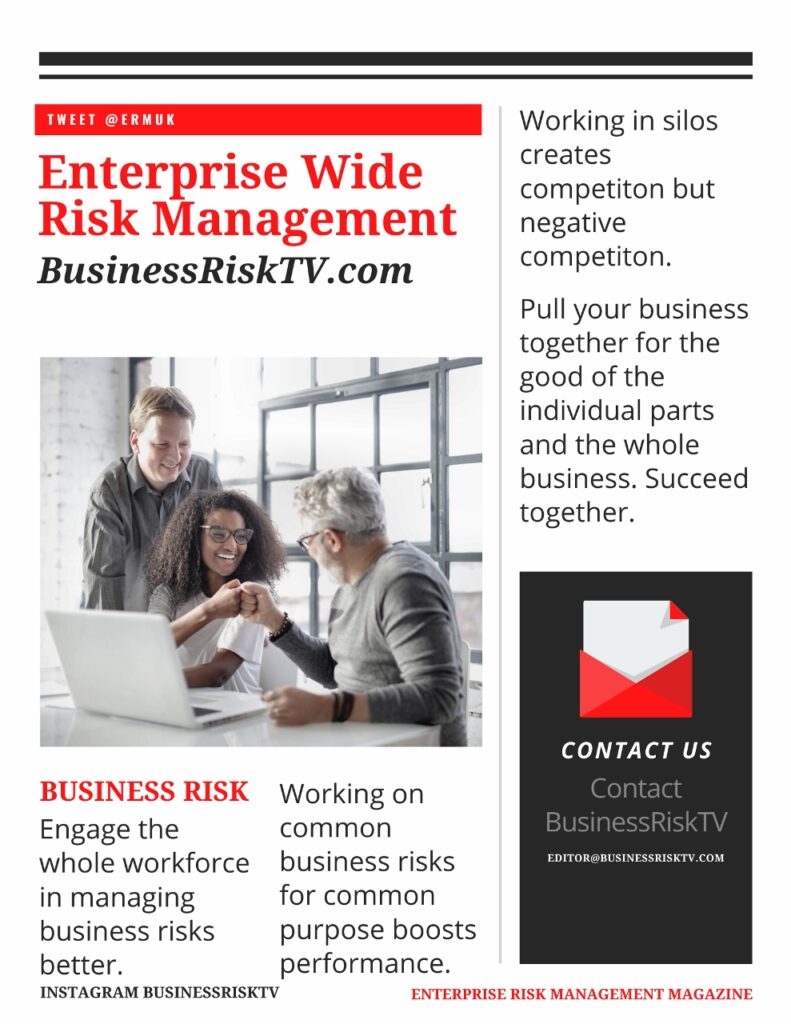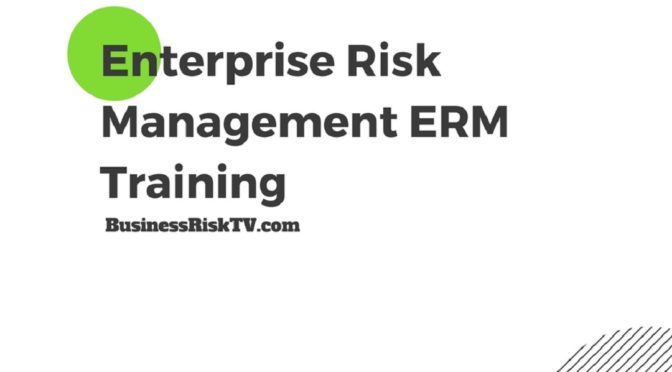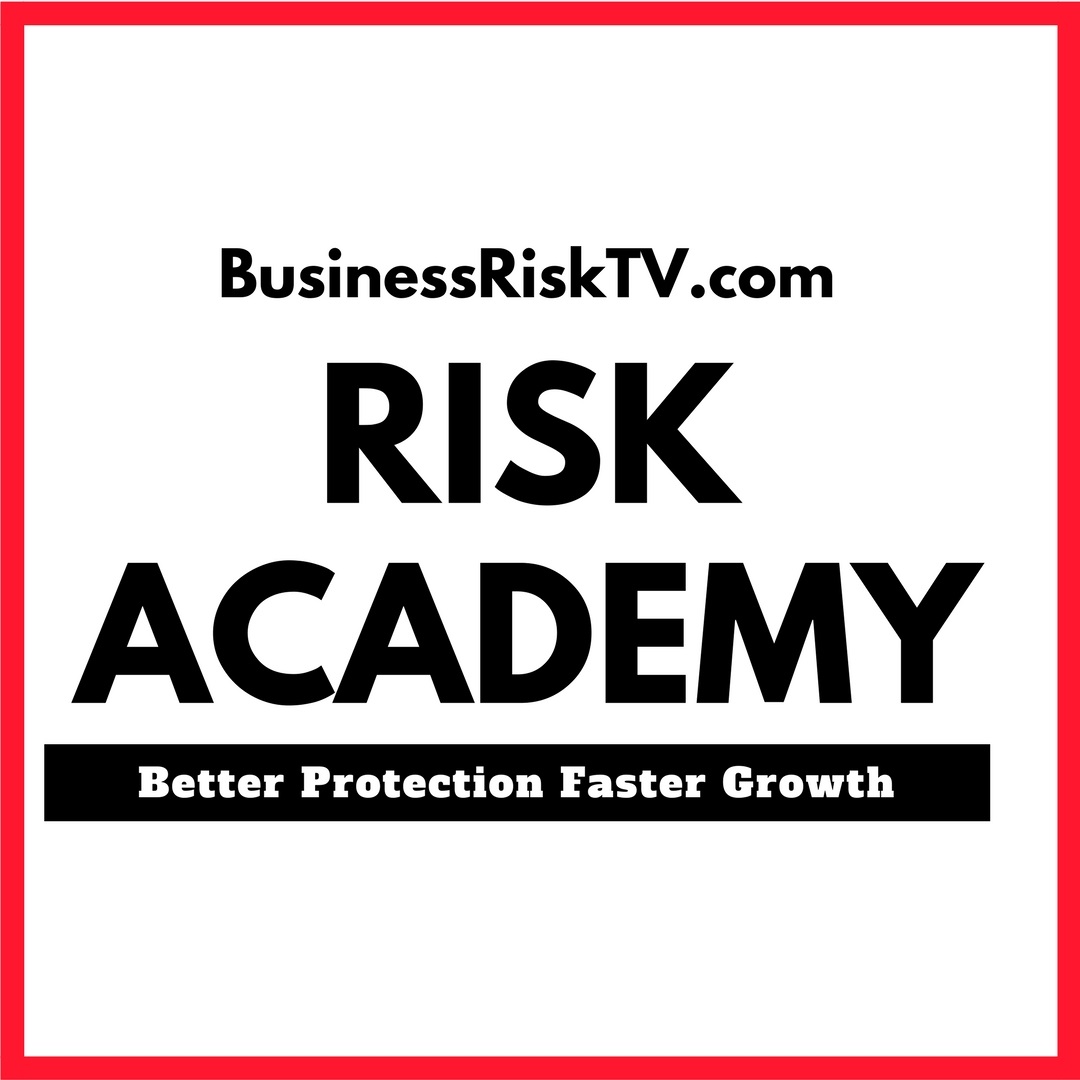Objectives of Enterprise Risk Management ERM
Enterprise risk management theory and practice can help to boost your business. Are you interested in enterprise risk management theory and practice? Keep up to date with latest enterprise risk management theory and practice news opinions and reviews. Network with enterprise risk management experts and top business leaders locally and globally.

Enter code #EnterpriseRiskManagement
Enterprise risk management theory and practice is an holistic approach to business decision making. It is designed to make the best use of business resources.
- Achieve enterprise objectives more easily and cost effectively by reducing the impact of uncertainty.
- Improve business decision making when looking at business strategy operational management and project management.
- Engage the whole workforce in the task of making the enterprise a success.
Learn strategies to develop collaboration with enterprise risk management development within your business. Create an efficient risk management framework and risk assessment process you can communicate clearly to all employees to embed ERM more effectively.
Enterprise risk management creates value for all stakeholders in the enterprise including customers employees management team and owners.
Assess enterprise threats opportunities and their impact on enterprise objectives to use existing resources more cost effectively to achieve success more quickly and easily with less uncertainty.
BusinessRiskTV
Subscribe to BusinessRiskTV for free enterprise risk management ERM alerts bulletins and reviews to your inbox
| Marketplaces | Exhibitions |
| Save Money | Risk Magazine |
Guide To Enterprise Risk Management
In today’s dynamic and interconnected business landscape, managing risks has become an essential aspect of successful enterprise management. Organisations face a wide range of risks, including financial, operational, strategic, and reputational risks, which can significantly impact their ability to achieve objectives and thrive in a competitive environment. Enterprise Risk Management (ERM) provides a comprehensive framework and process for identifying, assessing, and mitigating these risks to ensure sustainable growth and resilience. This article serves as a guide to understanding and implementing ERM within organisations.
- Understanding Enterprise Risk Management:
Enterprise Risk Management is a strategic approach that enables organisations to proactively identify, assess, and manage risks across all levels and functions. It involves the systematic integration of risk management practices into an organisation’s decision-making processes, governance structure, and operations. ERM goes beyond traditional risk management, which often focuses on isolated risks, by considering the interdependencies and cumulative effects of risks on an enterprise-wide basis.
- Key Components of Enterprise Risk Management:
a. Risk Identification: The first step in ERM is identifying and cataloging all potential risks that may affect the organisation. This involves gathering information from various sources, including internal stakeholders, external experts, industry reports, and historical data. The goal is to create a comprehensive risk register that captures both known and emerging risks.
b. Risk Assessment: Once risks are identified, they need to be assessed in terms of their likelihood of occurrence and potential impact. This step involves qualitative and quantitative analysis to prioritise risks based on their significance. Risk assessment techniques may include scenario analysis, sensitivity analysis, and probabilistic modeling.
c. Risk Mitigation: After assessing risks, organisations develop risk mitigation strategies to reduce the likelihood or impact of identified risks. These strategies may involve implementing controls, transferring risks through insurance or contracts, accepting risks within predetermined tolerance levels, or avoiding risks altogether by changing business practices or diversifying operations.
d. Risk Monitoring and Reporting: ERM is an ongoing process that requires continuous monitoring of risks to ensure their effectiveness. Organisations should establish clear risk indicators and thresholds to detect changes in risk levels and trigger appropriate actions. Regular reporting on risk exposures, mitigation efforts, and performance against risk objectives is essential to keep stakeholders informed and accountable.
e. Risk Culture and Communication: ERM is most effective when risk management becomes an integral part of an organisation’s culture. This involves fostering a risk-aware mindset among employees, encouraging open communication about risks, and embedding risk management practices in daily operations. Effective communication channels should be established to facilitate the flow of risk-related information across all levels of the organisation.
- Benefits of Enterprise Risk Management:
Implementing ERM brings several benefits to organisations:
a. Improved Decision Making: ERM provides decision-makers with a holistic view of risks, enabling them to make informed choices that align with the organisation’s risk appetite and strategic objectives. By considering risk factors, organisations can avoid costly mistakes and capitalise on opportunities.
b. Enhanced Resilience: ERM helps organisations become more resilient in the face of uncertainties and disruptions. By systematically managing risks, organisations can better anticipate and respond to potential threats, minimising their negative impact and quickly recovering from adverse events.
c. Competitive Advantage: Effective ERM enables organisations to differentiate themselves by demonstrating strong risk management practices to customers, investors, and regulators. This can enhance their reputation, attract new business opportunities, and improve access to capital.
d. Regulatory Compliance: ERM assists organisations in complying with applicable laws, regulations, and industry standards. By proactively managing risks, organisations can identify compliance gaps and take corrective actions to avoid penalties and reputational damage.
e. Cost Optimization: ERM helps organisations optimise resource allocation by identifying areas of inefficiency, waste, or excessive risk-taking. By streamlining processes, eliminating redundancies, and aligning risk management efforts, organisations can reduce costs and improve operational efficiency.
- Implementing Enterprise Risk Management:
To successfully implement ERM, organisations should consider the following steps:
a. Leadership Commitment: Senior management should demonstrate a strong commitment to ERM and actively champion its adoption throughout the organisation. This includes allocating resources, defining roles and responsibilities, and fostering a risk-aware culture.
b. Risk Governance: Establish a clear governance structure for ERM, with defined roles, responsibilities, and reporting lines. Designate a risk officer or risk management team to oversee the ERM process and ensure its integration into decision-making at all levels.
c. Risk Framework: Develop a risk management framework tailored to the organisation’s specific needs and industry context. This framework should outline the key components of ERM, including risk identification, assessment, mitigation, monitoring, and reporting.
d. Risk Assessment and Prioritisation: Conduct a comprehensive risk assessment to identify and prioritise risks based on their potential impact and likelihood of occurrence. This assessment should involve input from relevant stakeholders and utilise appropriate risk analysis techniques.
e. Risk Mitigation Strategies: Develop and implement risk mitigation strategies that align with the organisation’s risk appetite and strategic objectives. These strategies should be tailored to address specific risks and may involve a combination of controls, risk transfer mechanisms, and process improvements.
f. Integration with Business Processes: Embed risk management practices into existing business processes and decision-making frameworks. This includes integrating risk considerations into strategic planning, project management, performance evaluation, and budgeting processes.
g. Training and Awareness: Provide training and awareness programs to educate employees about ERM principles, methodologies, and their role in managing risks. Foster a culture of risk awareness, where employees are encouraged to report and escalate potential risks.
h. Continuous Monitoring and Improvement: Establish a system for ongoing risk monitoring and reporting. Regularly review and update the risk register, assess the effectiveness of risk mitigation measures, and identify emerging risks. Continuously improve the ERM process based on lessons learned and feedback from stakeholders.
- Overcoming Challenges in Enterprise Risk Management:
Implementing ERM can present challenges, but organisations can overcome them with proper planning and execution:
a. Organisational Silos: ERM requires collaboration and information sharing across different functions and departments. Breaking down silos and fostering cross-functional communication is essential for effective risk management.
b. Resistance to Change: Resistance to change can hinder the adoption of ERM. Organisations should invest in change management efforts, addressing concerns, and providing training and support to employees.
c. Data and Information Management: ERM relies on accurate and timely data and information. Organisations should establish robust data management systems, ensure data integrity, and leverage technology solutions for data collection, analysis, and reporting.
d. Risk Appetite Alignment: Aligning risk appetite across the organisation can be challenging. Clear communication and dialogue between senior management and relevant stakeholders are crucial to establish a shared understanding of risk tolerance and strategic objectives.
e. Evolving Risk Landscape: The risk landscape is continuously evolving, with new risks emerging and existing risks evolving. Organisations should stay updated on industry trends, regulatory changes, and emerging risks to ensure the relevance and effectiveness of their ERM practices.
Enterprise Risk Management is a strategic imperative for organizations to navigate the complexities and uncertainties of the modern business environment. By adopting a comprehensive ERM framework, organisations can proactively identify, assess, and mitigate risks, enabling them to make informed decisions, enhance resilience, and gain a competitive advantage. Successful implementation of ERM requires leadership commitment, a robust governance structure, integration with business processes, and a risk-aware culture. Overcoming challenges and continuously improving the ERM process will contribute to long-term success and sustainability in today’s dynamic business landscape.
#BusinessRiskTV #EnterpriseRiskManagement #ERM #RiskManagementNews #RiskManagementReviews #EnterpriseRiskManagementTraining
BusinessRiskTV Enterprise risk management theory and practice









